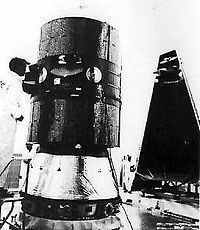COSPAR ID 1967-031A Bus HS-306 Launch date 6 April 1967 Launch mass 324.3 kg | SATCAT № 02743 Launch site Cape Canaveral LC-12 Period 3.6 hours Launch mass 324.3 kg | |
 | ||
Similar ATS‑1, ATS‑3, ATS‑4, ATS‑6, WRESAT | ||
ATS-2 (Applications Technology Satellite) was a communications satellite launched by NASA on April 6, 1967 on an Atlas-Agena D rocket from Cape Canaveral.
Contents
Objectives
The ATS-2 had the following objectives: test new concepts in spacecraft design, propulsion and stabilization; capture high quality images of cloud cover; collect data measurements in an aerospace environment; and test improved communication systems.
Features
The satellite had a cylindrical shape with a 142 centimetres (56 in) diameter and a height of 183 centimetres (72 in). After including the motor cover, the satellite was about 360 centimetres (140 in) tall. The surface of the satellite was covered by solar panels, and it utilized gravity-gradient stabilization for control.
Experiments
The following 12 experiments were conducted:
Mission
The launch of ATS-2 went entirely according to plan up to the first Agena burn. When the second burn was initiated, the Agena engine failed to restart and thus the satellite could not be placed in the correct orbit. Postflight investigation found that the oxidizer isolation valve had failed to close after the first burn. This valve was supposed to prevent propellant from escaping the tanks and filling the turbopump during the coasting phase, but since it remained open, the pump developed vapor lock and thus it became impossible to pump oxidizer in. A tiny amount of ISP was generated by the gas generator igniter cartridge. The low periapsis of the orbit caused the satellite to tumble more than the stabilization system could compensate, which complicated its mission. The satellite still produced some usable data from the experiments, most notably those regarding cosmic rays and particles. It reentered the atmosphere on September 2, 1969.
